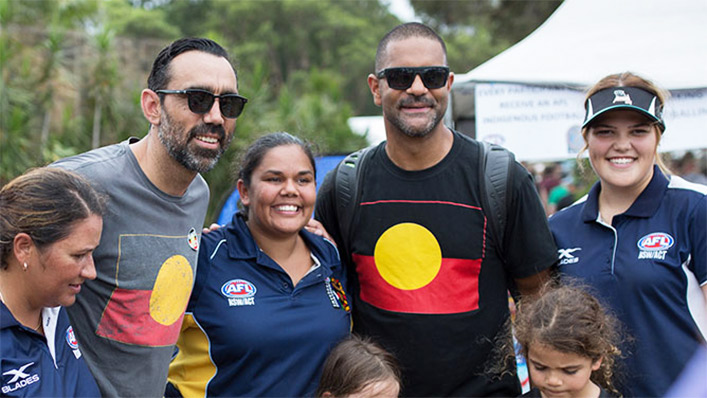Adam Goodes doco The Australian Dream is a fascinating study of modern Australia

The Australian Dream, which opened this year’s Melbourne International Film Festival, is the second documentary in recent times to explore the career of AFL superstar Adam Goodes. It takes us to a place that leads to the heart of modern Australia, says Blake Howard.
In his landmark essay, titled The Australian Dream, Stan Grant wrote:
“Indigenous lives have been framed by suffering. This resonates because it is rooted in fact. Our land was seized, our rights were extinguished, we were shot down and stricken with disease, our liberty was curtailed and our children taken. It is a story of injustice that explains residual anger.”
The Australian Dream is the second documentary this year to focus on the final days in the career of AFL superstar Adam Goodes. The other is The Final Quarter, which reassembles the events of 2013-2014 into a cohesive narrative: just the reported facts. In contrast, The Australian Dream tackles the saga with the benefit of hindsight, taking us into deeper layers exploring the motivations behind the actions of those involved. Grant and director Daniel Gordon focus of Goodes’ saga as a case study, taking us to a metaphorical river mouth that leads to the heart of modern Australia.
Writer Stan Grant is an essential voice to corral this story. Goodes’ shine, rather than being seen as a beacon directing this country to a brighter future, received a Promethean punishment. Each game shackled Goodes to an arena for disturbing, disheartening, racial lashing. The frequency of Goodes’ moment jolts grant, and its vibrations through the history of this country.
Goodes became an activist out of necessity, standing on the platform afforded by his position, to be a symbol for healing. Goodes, imbued with the power of historical truth, attempted to break through using a universal language unblemished by political spin. This defiance triggered a howling echo from history. The boos were screeching “you’re not like us.”
Grant helps to reframe the events that closed the curtain on Goode’s career, with shared stories of vilification. Indigenous player Nicky Winmar trail-blazed and stands like a historic totem; as a defiant and proud voice in a much more overt and hostile racist iteration of this country. The crucial re-framing is that by the time we arrive at the continuum of Goodes’ the only thing that seems to matter is the inherent bias of those tarred with the racist brush.
Goodes’ journey of self-discovery was an awakening. After a more in-depth exploration of his personal history, through his mother– Lisa May – the film examines his past pain. May, like so many members of the Stolen Generation, were too fragile to burden her children with the trauma. They yearned for the next generation to escape the sorrow and the stigma.
Gordon’s style toggles between two distinct approaches. The first is detached surveillance, standing apart from Goodes to observe and capture his contemplation silently. The second is a more overt interrogation. In profiles with critical figures such as Andrew Bolt and Eddie McGuire, Grant’s inquisition and Gordon’s stillness creates space for reflection, redemption, or in Bolt’s case righteous indignation.
The Australian Dream is to The Final Quarter what Hearts of Darkness: A Filmmaker’s Apocalypse is to Apocalypse Now. This documentary is fascinating, harrowing and candid, allowing – for better or worse – Goodes to have the final word on his ending.

















